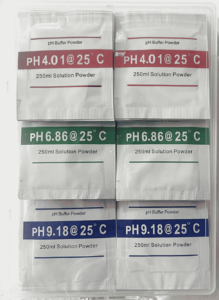
I recently received a box of sachets like what you see in the photo at right. Each sachet contains a few grams of white powder which, if mixed with 250 ml of water, yields a stable buffer solution of one of the pH values mentioned in the subject line.
What is so interesting about these three pH values? Why did the maker of these sachets pick these three pH values? And, the alert reader demands to learn, what exactly is in the sachets?

By way of background, I was astonished recently to learn that for a mere $8 one may purchase a pocket-sized pH meter, shown at right. How could such an inexpensive meter possibly yield accurate measurements, especially when compared with traditional pH meters costing hundreds of dollars?
It turns out that no matter how much or how little money you spend on a pH meter, it requires careful care and calibration. The meter uses what is called a “glass electrode” (Wikipedia article) as part of a potentiometric measurement of the pH of an aqueous solution. To yield accurate measurements, the pH meter needs to have been recently calibrated. The pH meter needs to be placed into a calibration mode, and the electrode needs to be immersed into each of three “buffer solutions” seriatim. And yes, you guessed it, the pH values for the three solutions will be 4.01, 6.86 and 9.18.
Once the calibration has been carried out, the meter will yield accurate pH measurements for some hours or days, until the glass electrode dries out. The next calibration process gets the electrode wet again, so that the electrode is once again able to do its job in a predictable way.
The user will have previously used three of the sachets shown above, with distilled water, to to fill three bottles each containing a calibration buffer solution. The three bottles can be kept on the shelf for a year or more, to be used in future calibrations.
Which brings us back around to the question — what is so special about these three pH values? The answer lies in a document published half a century ago by the National Bureau of Standards. The document, entitled Standardization of pH Measurements, is NBS publication number 260-53 (archived here). Upon several readings, the alert reader will gradually discern that the authors of the publication must surely have begun their work by asking something like this:
What chemical can we find lying around in our laboratory that dissolves easily in water, is inexpensive, is easy to weigh accurately, is easy to work with, is not hazardous, is easy to store and shelf-stable in powdered form, and (this is the important part) will reliably give rise to a buffer solution with a predictable pH?
(By “buffer” we mean a solution that maintains its pH despite small amounts of added acid or base.)
And while we are at it, let’s add further requirements that the buffer solution be stable in liquid form when stored on the shelf for some months or more, be unaffected by modest temperature variations, and be unaffected by ambient light.
To yield accurate measurements, the pH meter would need to be calibrated at several pH values at various points along the pH scale of 0 to 14. A typical calibration approach uses three reference solutions, permitting two interpolations (each between a pair of calibration points) and two extrapolations (above and below the highest and lowest calibration points). Which means that three chemicals (or mixtures of chemicals) would need to be selected, that satisfy all of these ten or so requirements.
Over the course of a half century that has passed since this NBS document got published, the chemicals that have come to be commonly used are:
-
- potassium hydrogen phthalate (Wikipedia article) (KHC8H4O4) at 0.05 m (yielding a pH of 4.01),
- a mixture of monopotassium phosphate (Wikipedia article) (KH2PO4) and disodium phosphate (Wikipedia article) (Na2HPO4) at 0.025 m each (yielding a pH of 6.86), and
- sodium tetraborate decahydrate (Wikipedia article) (Na2B4O7 • 10H2O) at 0.1 m (yielding a pH of 9.18).
Trivia buffs will enjoy learning from the Wikipedia articles that indeed the chief use of potassium hydrogen phthalate (Wikipedia article) is for calibration of pH meters. Monopotassium phosphate (Wikipedia article) is one of the chief ingredients of sports drinks such as Gatorade. Sodium tetraborate decahydrate (Wikipedia article) is just a fancy name for borax.
It will be recalled that everything about pH is affected by temperature. So the pH meter will also have a temperature sensor, and the measured temperature of the aqueous solution being tested is used as part of the calculation that leads to the displayed pH value.
Each sachet shown above contains a measured amount of the relevant powder so that when dissolved in 250 ml of distilled water, it will yield the desired pH. A set of 36 such sachets (12 each of the three pH values) might cost $9.
I think it is fascinating that a person who does not mind keeping some calibration solutions on the shelf, and who does not mind diligently carrying out calibrations from time to time, can accomplish accurate pH measurements at a cost of only a few dollars.

Last time I tested Tabasco sauce it came out 2.75.
If you & the kids like spicy stuff, you can test several of these condiments and show that spiciness is not necessarily correlated to acidity.